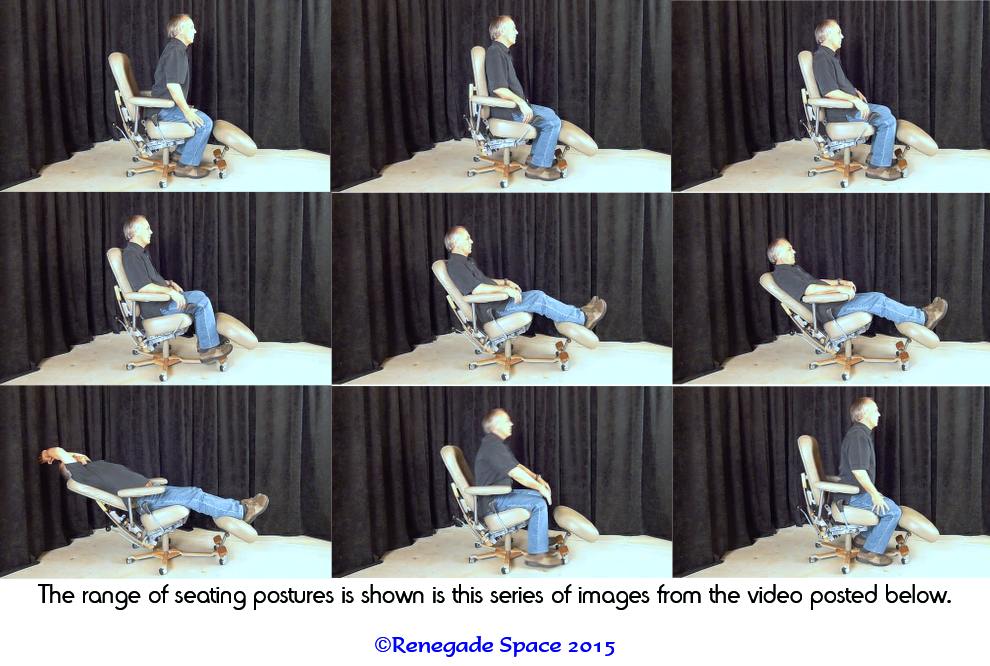HOME • FUTURE OF SEATING • THE 90 DEGREE PARADIGM • SITTING AND ITS DISCONTENTS
CATEGORIES OF CHAIRS • SIT STAND TREADMILL • CONTACTS
COMMENT IN A BLOG

 I. Why a Hybrid? • II. Who are You Targeting? • III. What’s different About the Chair?
I. Why a Hybrid? • II. Who are You Targeting? • III. What’s different About the Chair?
IV. Next Generation in Seating? • V. Health Benefits of a Hybrid
VI. Design Considerations: Gravity • VII. Functions: How does it Work?
The seating device, or chair, that you see in the slide show of the header of this site may look a little strange to you. That’s because you have never seen anything like it. Among classes of chairs, it is called a hybrid, because it incorporates features of several different approaches to seating. Specifically, it is a variable posture seating device, one which makes available to a seated user the full range of usable positions at a workstation. It enables the design and building of a recumbent workstation, although it is much more. It incorporates movement and fluidity into the process of seating, and is designed to be extremely comfortable and easy to use.
This particular design came out of a garage in Avon, Colorado, was engineered by a group of students in mechanical engineering at CU Boulder and prototyped at a prison in southern Colorado by a company called Colorado Correctional Industries. It is in no way connected with the U.S. $23 billion office seating industry. It is a home grown Colorado product, an outlaw design, if you will. It is Renegade Space™.
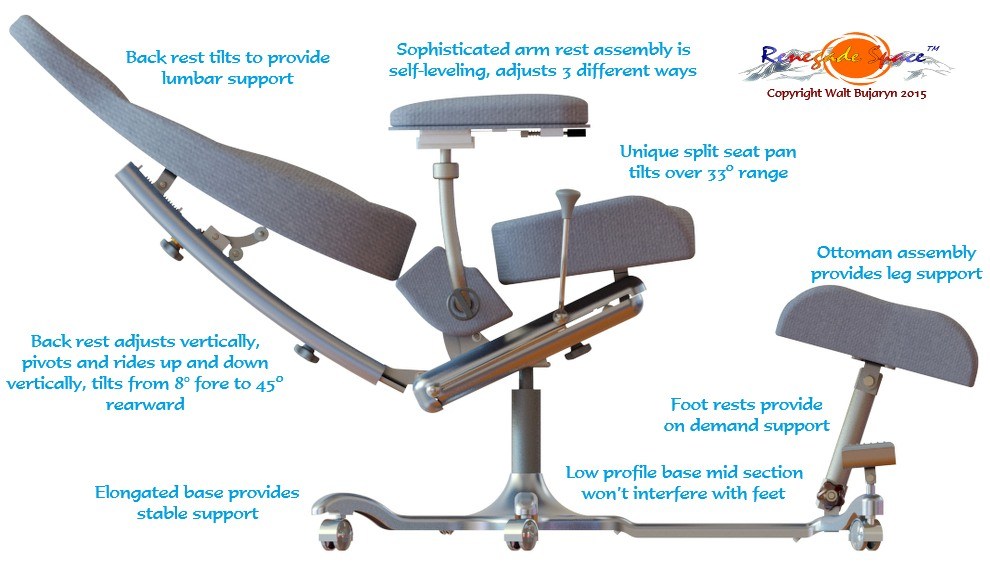
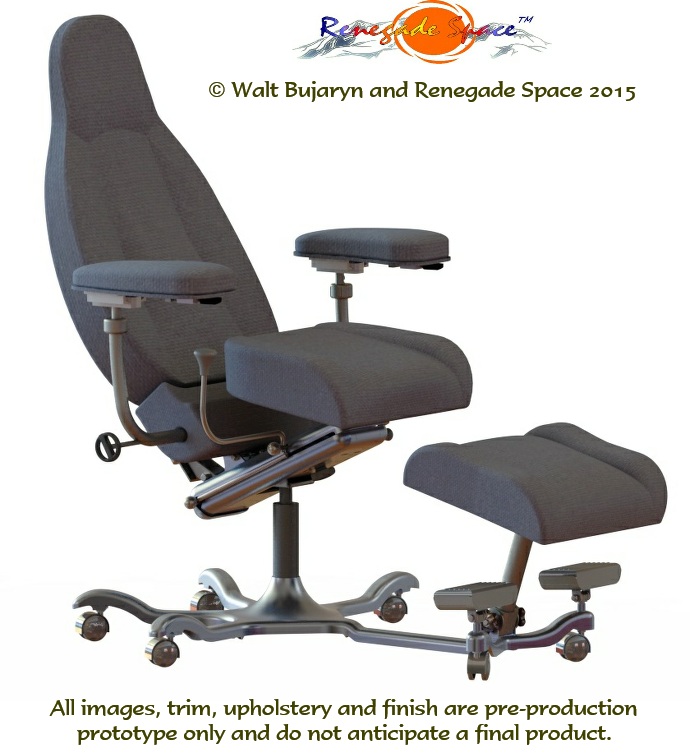 I. Why a Hybrid? And why a recumbent workstation?∧
I. Why a Hybrid? And why a recumbent workstation?∧
In a single word, comfort. Comfort enables long term seating. Comfort enhances productivity. Comfort leads to better health. A comfortable workstation is one that is designed with the biomechanical needs of a human being in mind. And a comfortable workstation is one that is psychologically powerful, one where work is a joy, not a task. The delivery of comfort to a seated user is the core tenet of Renegade Space philosophy, the one we have been working on since day one in the garage in Colorado.
The Renegade Space™ hybrid model not only defines the full range of seating positions at a workstation, it makes them available to a seated user through exceptional ease of use. The design instills fluidity and movement into the process of sitting. The feathering of a single intuitive lever enables one to cycle continuously through this range of positions, locking down at any chosen point as needed. And simply rocking through the unlocked range is always an option. Gone are the days of multiple confusing paddles hidden under a seat pan. This enables a user to instantly respond to the sitting needs of his or her own body and instills a new range of power and control over the process of sitting.
A variable posture, or hybrid workstation that incorporates recumbency into its options is long overdue. It is the next generation in seating and is the answer to the deficiencies of the 90 degree workstation [link]. The hybrid design defines and masters the gravitational forces of sitting (see below). Recumbency enables a seating device well suited to long term, or marathon, sitting. And the use of a hybrid chair means the workstation isn’t limited to recumbency. It also includes task, executive and kneeling postures, and can function as a horizontal stretching device. To reiterate, and we can’t repeat this enough, it incorporates movement and fluidity into the process of seating, and is designed to be extremely comfortable and easy to use.
Until now there were numerous problems with building a functional variable posture or recumbent workstation, chief among those being the lack of a suitable seating device. An actual willingness to undertake the effort has also been absent, and cultural blocks in the corporate world to the concept of “reclining” while at a desk environment all combined to make it a non-starter. But the devastating effects of what is being called workplace seating disease and a change in attitudes mean the time has now come to create an alternative for our aging workstation paradigm, one that recognizes the marathon aspect of modern sitting and which places worker health and comfort at the forefront of our design thinking.
II. Who are you targeting?∧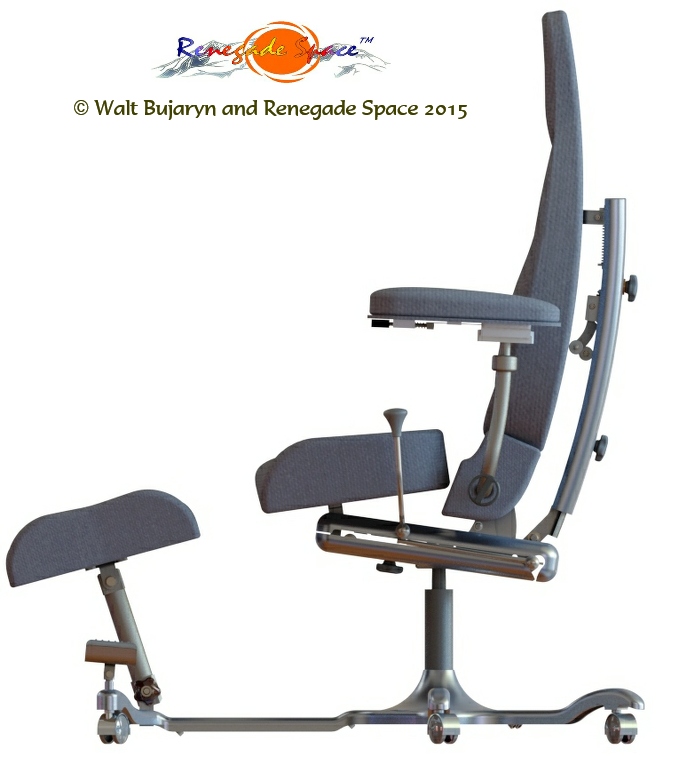
We have specifically targeted the long term or “marathon” user of a workstation, someone who spends 8 to 14 hours a day in a chair. Based on an eight hour workday one can sit at a workstation 2000 hours a year, 10,000 in five, and many do more. When we drafted the original engineering proposal it was as a “Mission Critical Seating Device” targeted toward extreme sitters needing to maintain maximum mental acuity. Drone operators in the military would be one example; 911 and other call centers would be another. Engineers, architects, programmers, web designers, those in similar fields… all of these are part of our target markets.
We’re also after those who suffer day in and day out in a conventional seating device. Diabetics, back pain sufferers, cardio patients, anyone with diseases of the extremities, narcoleptics, amputees… it’s a long list, and we want to offer these people a meaningful, and possibly life changing alternative. We want to do multi seat installations, but we’re also after the lone wolf in a home situation.
And since the device works equally well as a task chair and a full recliner and yet takes up no more space than an ordinary chair, those who are in situations where they are constantly up and down all day and would like a better seating alternative should take a good look at what Renegade Space™ has to offer.
III. What’s different about the chair?∧
Everything. In building the design, we tore the conventional efforts apart and reassembled components to come up with a design that is completely unlike and far superior to anything on the market today. We started by freeing the planes of body support in a chair from their linkage and letting them float individually. We then reconnected them as individual components in a completely new way that enables a chair to work in absolute harmony with the human body over the entire range of possible seating at a workstation.
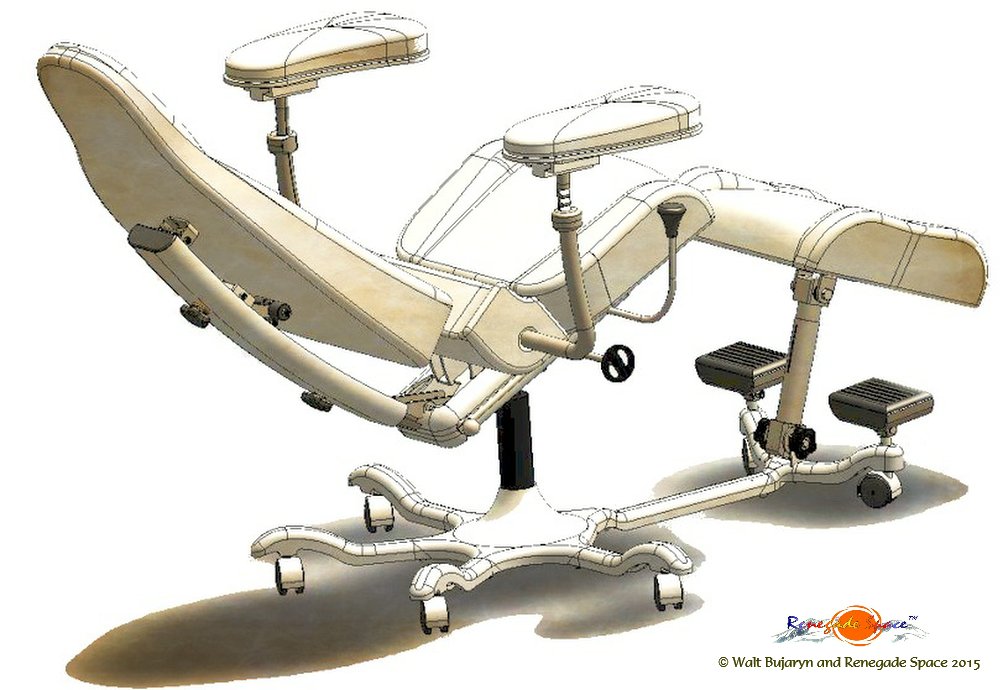 Many, if not most conventional chairs build as a single unit, the seat pan, back rest and arm rests all being tied together. Movements and adjustments have to be engineered within these restrictions, and the results are less than spectacular. By building a chair wherein the planes of body support, i.e. the seat pan, back rest, arm rests and ottoman support are detached from and operate independently of each other, a far greater range of functional movement is achieved. And this is not some marketing gimmick; it is an approach that delivers real benefits to a seated user that are perceived as being incredibly comfortable.
Many, if not most conventional chairs build as a single unit, the seat pan, back rest and arm rests all being tied together. Movements and adjustments have to be engineered within these restrictions, and the results are less than spectacular. By building a chair wherein the planes of body support, i.e. the seat pan, back rest, arm rests and ottoman support are detached from and operate independently of each other, a far greater range of functional movement is achieved. And this is not some marketing gimmick; it is an approach that delivers real benefits to a seated user that are perceived as being incredibly comfortable.
The chair is designed around the concept of True Variable Posture™. While many modern conventional chairs have been inching away from the stifiling confines of the 90 degree paradigm by enabling a greater range of movement, Renegade Space™ moves farther and breaks those chains completely. By tilting a seat pan over a range of 33°, 8° forward to 25° to the rear, and enabling a user to lock that pan down at any point within that range, we give a seated user access to the full range of possible seating at a workstation. And we enable them to access that range with great ease and fluidity of movement.
This range of variable posture movement covers everything from leaning forward and into one’s work to a full working recline, one that can be sustained for greatly extended periods, and everything in between. It is a kneeling posture chair, a task chair, an executive chair, a partial recliner and a full recliner. It is a stretching device, enabling a user to stretch out fully horizontal and then cycle back to an upright position without tipping the chair over. You can tuck your feet under the seat pan, place them flat on the floor, elevate them onto foot pads or stretch the legs out into an elevated recline. When you want to stand, you can stand, for as long as you want. And it enables a user to achieve all of these positions fluidly and easily, with the operation of a single lever and by simply standing up in place. It is an incredibly versatile seating device. It is a hybrid, the only one of its kind.
IV. You state this is the “Next Generation” in seating. Why?∧
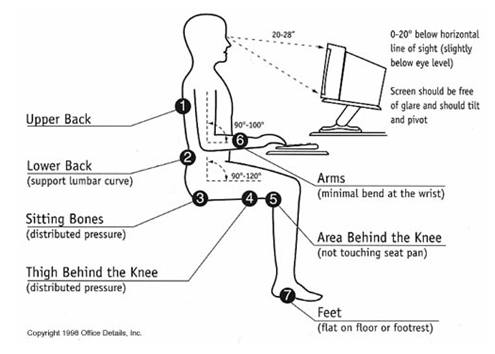 For years the 90 degree paradigm [link], which is covered in great detail on another page on this site, has been the instruction set on how to use a chair at a workstation. While conventional chair manufacturers have been stretching the limits of the paradigm in recent years it remains the model of seating around which the modern workstation has been designed. Without belaboring existing content we can state that this is a static model of sitting which incorporates periodic breaks to offset the stresses that build within the posture. The model has become outdated and is in need of replacement.
For years the 90 degree paradigm [link], which is covered in great detail on another page on this site, has been the instruction set on how to use a chair at a workstation. While conventional chair manufacturers have been stretching the limits of the paradigm in recent years it remains the model of seating around which the modern workstation has been designed. Without belaboring existing content we can state that this is a static model of sitting which incorporates periodic breaks to offset the stresses that build within the posture. The model has become outdated and is in need of replacement.
The Renegade Space™ paradigm specifically rejects any one position as the “correct” or “healthy” model of sitting, although the recumbent or reclining position is seen as offering the greatest long term sustainability. Instead, Renegade Space™ posits a full range of seating positions under the moniker of True Variable Posture™. True Variable Posture™ enables a complete change in the gravitational (i.e., positional) forces on a body while sitting, and enables a sitter to sustain those changes for as long as he or she deems necessary. This might be called “variable task” sitting, where positions change regularly.
The images below were generated by the CU Boulder engineering team at the last moment. While not exact or sophisticated they do show the basic range of seating available under the True Variable Posture™ concept, all the way from leaning forward and into one’s work to a full horzontal stretch. This would be a range of positional change, all of which is useful and sustainable as a static posture, covering some 50 degrees of vertical body change. This is the “Next Generation” in seating and it is the model around which Renegade Space™ is built.
V. Any health benefits with a hybrid?∧
There are two pages on this site dealing with the problems associated with what is called “workplace seating disease”: “Revisiting the 90 Degree Paradigm” [link] and “Sitting and its Discontents”[link]. We invite the reader to familiarize him or herself with the contents of those pages to get an overall view of how Renegade Space™ views those issues. Workplace seating disease is a complex matter and the degree to which any one solution can affect the problem is an open question. We will, however, attempt to address key issues in bullet points as follows:
• The Renegade Space™ model specifically recognizes and is designed to at the very least accommodate and hopefully ameliorate a range of specific health problems associated with sitting. This would include, but not be limited to, diseases of the spine, including general degeneration; low back and hip pain; diseases of the extremeties, where elevating the legs is preferable to the alternatives; obesity; diabetes; amputees; narcolepsy; circulatory and other cardiovascular conditions, and general problems associated with aging, among others. It would inevitably be up to an individual user to determine to what extent the device can actually help his or her specific condition;
• Stress is a major problem with extended static sitting, and through its True Variable Posture™ model Renegade Space™ offers a significant offset to the accumulation of stress. The model enables a user to easily and fluidly cycle through the full range of positions that are usable at a workstation. This is not a model of confined immobility requiring constant breaks of physical offset as in the 90 degree convention, and the stresses that build in a seated position should be substantially decreased. In fact, the entire model is structured with the overall goal of decreasing physical stress at every level. This should enable a user to remain seated for longer periods thereby decreasing negative health issues and enhancing productivity;
• The Renegade Space™ model recognizes a clear distinction between short and long term sitting, and makes provision for both. A conventional seating device is generally, if not entirely, structured to accommodate short term sitting only, and trying to apply that model to the long term, or marathon sitter has had serious adverse health consequences;
• Renegade Space™ builds a device with a strict emphasis on delivering comfort and ease of use to a seated user. This alone can deliver a significant physical and psychological benefit by making the workstation a more inviting place to be for longer periods of time;
• Renegade Space™ recognizes that there are few practical modalities with which medical practitioners can treat the tsunami of back problems with which they must deal on a daily basis. By giving them the option of suggesting a full and complete change in method of sitting we hope to initiate a meaningful alternative in the treatment of workplace sitting disease.
VI. Design considerations: Gravity is Master∧
“Our physical relationship with gravity determines whether our journey through life will be one of buoyancy and lightness or tension and struggle. To encourage structural balance, we need to align the energy field of the human body with the gravitational field of the earth so that they are able to relate to each other in a mutually supportive manner. If our bodies can assume the structural coordinates that allow for this relationship, then we become balanced, and we reap a sense of well-being as a natural and inevitable consequence. If we are unable to do so, then the experience of well-being becomes maddeningly elusive…” –Will Johnson, Gravity: Balance of Body – Balance of Mind
• Gravity is neither inconsequential nor to be taken for granted. Gravity is the means of design and assembly of the physical universe. In the far distant past, life manifested and assembled in tandem with, or as an opportunity in response to, the force of gravity. Ultimately, this will all come to an end: We Are Dead Stars;
• Gravity is that which makes life possible. The design of the human body is dictated by gravity, the force that pervades every cell in our body every second of our lives. The body, in fact, is continuously seeking to maintain equilibrium with gravity. One offset to the negative potential of gravity is movement; another is sleep. Certain builders of workstations have attempted to define one posture or another as “neutral”, but this is meaningless. The only possibility of “neutrality” in the body position is the one attained in the zero gravity of outer space. Terrestrial bound beings remain tethered within the gravitational field and must constantly realign their bodies within that force;
• Failure to keep a physical organism in equilibrium with gravity leads to stress. This in turn leads to pain, then chronic pain, then degenerative disease. Stress can be offset at a workstation through movement and the variable configuration of certain constants;
• Gravity at a workstation manifests as three variable constants: Load, weight bearing surface and footprint. To this we must add angles of support. Understanding and mastering these elements is crucial to the building of a successful seating device;
• Load: The body, or more precisely, every cell in the body. The body is made up of bone, or structure, which is relatively rigid but flexible, and skin, fat and muscle, which is relatively soft and pliable. Both must be recognized and accommodated;
• Weight bearing surface: The surface on which the load will be supported. The weight bearing surface is the interface between the load and the pull of gravity. In a chair, it is the seat pan, back rest, arm rests, foot and leg rests and the floor. How this is configured will have a significant effect on achieving the goal of delivering comfort to a seated user;
• Footprint: The amount of weight bearing surface that is devoted to supporting the load. At a workstation a smaller footprint is suitable for short term or task seating only; longer term or marathon sitting demands a larger footprint. Smaller footprints, such as that mandated by the 90 degree paradigm, put more weight on a smaller portion of the body, in this case the buttocks. The feet handle an inconsequential part of that load. The construction of the load bearing seat pan is a major determinant as to how long a user can maintain this position. Thin, hard seat pans lead to a crushing of skin and muscle and demand frequent relief. Well padded seat pans enable longer upright sitting sessions. In the reclining, or recumbent position virtually the entire body is supported by the weight bearing surface, thus minimizing the effect of gravity on any specific portion of the body and thereby enabling extended sitting.
• Angles of support: How the planes of the weight bearing surface are to be configured. In the Renegade Space™ design those planes are variable and designed to give a user access to the full spectrum of possible seating positions at a workstation. Varying the angles of support is the mechanism to effect variable posture, and enables a full change in the body’s center of gravity while varying the footprint.
VII. Functions: How does it work?∧
In U.S. Patent 5984408 Bujaryn showed how to employ a compound lever to effect a differential in tilt among a seat pan, a back rest, arm rests and an ottoman assembly in a seating device. The purpose of the design is to enable a user to access the full range of potential sitting at a workstation, this being the definition of variable posture. Key to the design is the ability to tilt a seat pan over a range of 33 degrees while keeping the movements of all other chair elements in harmony with that range of tilt.
https://www.youtube.com/watch?v=W-pubvIC7Jc
The following animation, which was produced by the engineering team at CU Boulder, shows the basic chair movements:
https://www.youtube.com/watch?v=yofW8R7UDX8
To summarize the major design elements:
The chair is comprised of a split seat pan, a back rest, two arm rests, an ottoman assembly that acts as both a foot and leg rest, and a low profile base designed both for stability and non-interference with a user’s feet;
The seat pan tilts over a range of 33 degrees. The pan may rock freely over, or be locked down at any point within that range. This enables a user to access the full range of seating potential at a workstation;
The backrest and armrests are independent of one another and the seat pan, and yet are designed to work in complete synchronization as the chair elements change position;
The arm rest assembly is self-leveling, enabling the entire design to function. To reiterate, the Renegade Space™ design tilts a seat pan over a range of 33 degrees while enabling its associated armrest assembly to remain completely horizontal, or at a small variation from the horizontal, over that range of tilt. This feature enables continuous arm alignment with a work surface, and that alignment may be tilted as a user needs;
The design enables a use to keep his or her feet on the floor, on foot rests, or elevated onto a leg rest as the selected position mandates.
TOP • HOME • FUTURE OF SEATING • THE 90 DEGREE PARADIGM • SITTING AND ITS DISCONTENTS • CATEGORIES OF CHAIRS • SIT STAND TREADMILL • CONTACTS • COMMENT IN A BLOG

